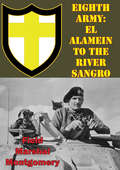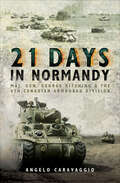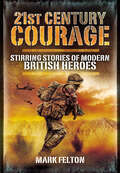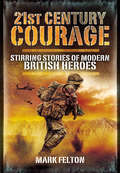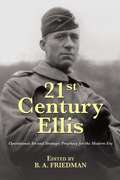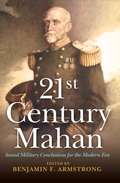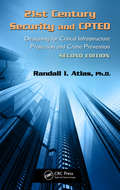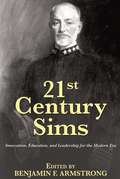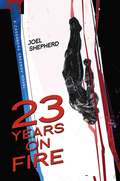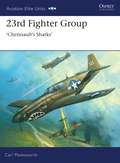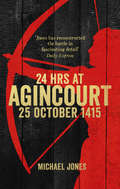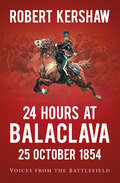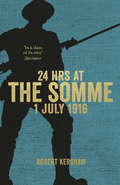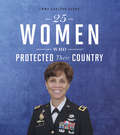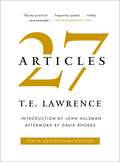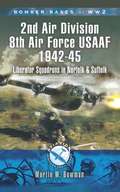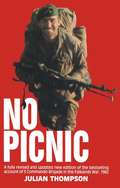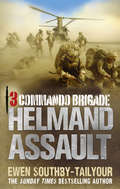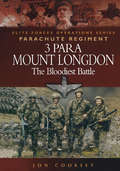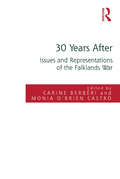- Table View
- List View
21 Army Group: Normandy To The Baltic [Illustrated Edition] (Memoirs Of Field Marshal Montgomery #1)
by Field Marshal Viscount Bernard Law Montgomery of Alamein KG GCB DSO PC[Illustrated with 46 highly detailed maps of the actions]Field Marshal Montgomery commanded the Eighth Army from 13th August 1942 until the 31st December 1943, and the 21st Army Group from 1st January 1944 until the German surrender on the 5th May, 1945. Whilst in command of the British Army of the Rhine, in occupation of Germany, shortly after the end of the Second World War Montgomery set out to record the exploits and victories of the troops under his command.Both this volume and its companion volume, El Alamein to the River Sangro, are superb examples of military history as presented by one of the greatest generals to command victorious armies in the field. The texts are taken from his personal war diaries and are distinguished by his incisive style. The whole strategy and course of these two campaigns are presented to the reader with great clarity and accuracy.In Normandy to the Baltic the Field Marshal unfolds that greater task -- the planning and implementation of the greatest invasion the world has ever known -- Operation Overlord. He describes the whole plan behind. D Day and the Battle of Normandy. He continues with the battle for Caen and the capture of Cherbourg, the closing of the Falaise Pocket and the crossing of the Seine--through into the Low Countries and the Battle of Arnhem and the famous Battle of the Ardennes. He concludes with the battle of the Rhineland, the crossing of the Rhine and the rush across northern Germany to the final surrender. The whole pattern of the complex allied effort -- British, Canadian and American -- is described with extraordinary detail and each episode is analysed in retrospect.
21 Days in Normandy: Maj. Gen. George Kitching & the 4th Canadian Armoured Division
by Angelo Caravaggio&“Right[s] some of the injustices done to the Canadians&” on their maligned actions during the Invasion of Normandy. &“An absorbing account&” (Firetrench). The Canadian Fourth Armoured Division crossed the Channel in July 1944 to support the invading forces and assist in the Allied attempts to break out of the Normandy beachhead. They were heavily engaged in Operation Totalize and Operation Tractable but have been criticized for their failure to close the &‘Falaise gap&’ and complete the entrapment of withdrawing German forces. Their commander, Major General George Kitching, was relieved of his command after just twenty-one days in action. Angelo Caravaggio reexamines the division&’s performance and particularly that of its leadership. Using new information, he establishes that, despite entering battle for the first time during one of the most challenging phases of Allied operations in August 1944, the 4th Armoured Division, under Kitching&’s leadership, proved resilient and adaptive in overcoming the volatile and unpredictable nature of warfare in Normandy. The combat operations of August 1944 transformed the division into a battle-hardened combat formation that would later distinguish itself through its ability to generate a sustained drive across France out of the chaos and destruction of the Normandy battles. &“The author uses new information to demonstrate the unit did show flexibility and adapted to the battlefield quickly, despite being thrown into battle during one of the Normandy Campaign&’s critical phases. His arguments are detailed and based upon in-depth research, and the book has many detailed maps to help the reader follow the action.&” —Warfare History Network
21st Century Courage: Stirring Stories of Modern British Heroes
by Mark FeltonThe book examines examples of outstanding courage exhibited by people living in modern Britain. These include British servicemen and servicewomen serving in Iraq and Afghanistan, police officers, and ordinary civilians in Britain and around the world. All of the cases cited have been awarded gallantry medals by the British government since 2000.The purpose of the book is to inspire modern British people. In the past, the heroes of Empire were well-known and respected, but since the Second World War people have tended to associate heroism with celebrity instead. We hear footballers and actors described as heroes, and this demeans the word, and the real heroes of modern British society. The generations that fought the First and Second World Wars have often been held up as the greatest generations of British people. This book shows Britons that the kind of grit, determination, courage and willingness to have a go exhibited by previous generations are as alive now as they ever were, and heroes can come from all walks of life and all ethnic groups in modern Britain.
21st Century Courage: Stirring Stories of Modern British Heroes
by Mark FeltonThe book examines examples of outstanding courage exhibited by people living in modern Britain. These include British servicemen and servicewomen serving in Iraq and Afghanistan, police officers, and ordinary civilians in Britain and around the world. All of the cases cited have been awarded gallantry medals by the British government since 2000.The purpose of the book is to inspire modern British people. In the past, the heroes of Empire were well-known and respected, but since the Second World War people have tended to associate heroism with celebrity instead. We hear footballers and actors described as heroes, and this demeans the word, and the real heroes of modern British society. The generations that fought the First and Second World Wars have often been held up as the greatest generations of British people. This book shows Britons that the kind of grit, determination, courage and willingness to have a go exhibited by previous generations are as alive now as they ever were, and heroes can come from all walks of life and all ethnic groups in modern Britain.
21st Century Ellis
by Edited by B. A. FriedmanFor years, the Marine Corps has touted the prescience of Lieutenant Colonel "Pete” Ellis, USMC, who predicted in 1921 that the United States would fight Japan and how the Pacific Theater would be won. Now, for the first time, those predictions and other works by the "amphibious prophet” are available in print. Included is two works by Ellis on naval and amphibious operations, including Advanced Base Operations in Micronesia, the study of tactics and operations in the Pacific Ocean that the United States Navy and Marine Corps would use to win the war against Imperial Japan. Ellis describes the form and functions of a modern Marine Corps designed to win its Nation’s battles. Ellis’ ideas about how the Marine Corps should fight are still in use throughout the world today. Ellis’ ideas on amphibious operations are well known, but his ideas on counterinsurgency and conventional war have been overshadowed and forgotten. Ellis wrote two articles based on his warfighting experiences in the Philippines and as part of the American Expeditionary Force in Europe during World War I. These articles, last published in the early 1920’s, are both republished in this book and show Ellis as a prescient thinker who was ahead of his time. Ellis identifies concepts that the U. S. military struggles with even today, and that other thinkers would not identify for decades after Ellis’ death. Also included are six essays by the editor, introducing the ideas of Pete Ellis and putting them in a modern context. As the United States turns its focus to the Pacific, Ellis’ ideas can inform policymakers on the dynamics of strategy and warfare in the vast reaches of the Pacific Ocean. Edited by Captain B. A. Friedman, USMC, 21st Century Ellis reveals the strategic insights of Pete Ellis for then and now.
21st Century Mahan
by Benjamin ArmstrongAlfred Thayer Mahan's The Influence of Seapower upon History is well known to students of naval history and strategy, but his other writings are often dismissed as irrelevant to today's problems. This collection of five of Mahan's essays, along with Benjamin Armstrong's informative introductions, illustrates why Mahan's work remains relevant to the 21st century and how it can help develop our strategic thinking. People misunderstand Mahan, the editor argues, because they have read only what others say about him, not what Mahan wrote himself. Armstrong's analysis is derived directly from Mahan's own writings. From the challenges of bureaucratic organization and the pit falls of staff duty, to the development of global strategy and fleet composition, to illustrations of effective combat leadership, Armstrong demonstrates that Mahan's ideas continue to provide today's readers with a solid foundation to address the challenges of a rapidly globalizing world.
21st Century Security and CPTED: Designing for Critical Infrastructure Protection and Crime Prevention, Second Edition
by Randall I. AtlasThe concept of Crime Prevention Through Environmental Design (CPTED) has undergone dramatic changes over the last several decades since C. Ray Jeffery coined the term in the early 1970s, and Tim Crowe wrote the first CPTED applications book. The second edition of 21st Century Security and CPTED includes the latest theory, knowledge, and practice of
21st Century Sims
by Edited by Benjamin F. ArmstrongFor more than two decades at the beginning of the 20th century William S. Sims was at the forefront of naval affairs. From the revolution in naval gunnery that he led as a junior officer, to his advocacy for the Dreadnaught style all-big-gun battleship, to his development of torpedo boat and destroyer operations, he was a central figure in helping to prepare the U. S. Navy for World War I. During the war he served as the senior naval commander in Europe and was instrumental in the establishment of the convoy system that won the Battle of the Atlantic. Following the war his leadership as President of the Naval War College established the foundations of the creative and innovative Navy that would develop the operating concepts for submarines and aircraft carriers which would lead to success in World War II. Despite his dramatic impact on the U. S. Navy in the first half of the 20th century, Sims is a relatively unknown figure today. Overshadowed in our memory by the World War II generation of strategic Admirals, like Chester Nimitz and Raymond Spruance, he receives little attention from historians or professional naval officers. Despite the fact that he won a Pulitzer Prize for history, hardly anyone reads the books or articles he left as his legacy. This collection of six essays written by Sims illustrates why his thinking and leadership are relevant to the challenges faced in the 21st century. From the perils of military conservatism, to the responsibilities of the professional officer, to military downsizing and reform, he helped lay the foundations of the modern Navy. Armstrong’s introductions and analysis of these essays links them directly to the issues of innovation, professional education, and leadership that are as important at the start of this century as they were at the start of the last.
23 Years on Fire: A Cassandra Kresnov Novel (Cassandra Kresnov Ser.)
by Joel ShepherdCassandra Kresnov--a highly advanced hunter-killer android--returns to face down a rogue government's plot to eliminate free will. Commander Cassandra Kresnov has her hands full. She must lead an assault against the Federation world of Pyeongwha, where a terrible sociological phenomenon has unleashed hell against the civilian population. Then she faces the threat from a portion of League space known as New Torah, in which a ruthless regime of surviving corporations are building new synthetic soldiers but taking the technology in alarming directions. On the Torahn world of Pantala, Sandy encounters betrayal, crisis, and conspiracy on a scale previously unimaginable. Most challenging of all, she also meets three young street kids who stir emotions in her she didn't think she was capable of. Can the Federation's most lethal killer afford unexpected sentiment? What will be the cost if she is forced to choose between them and her mission, not only to her cause, but to her soul?
23rd Fighter Group
by Jim Laurier Carl MolesworthStaffed with inexperienced USAAF pilots and led by a handful of seasoned veterans of the American Volunteer Group (AVG), the 23rd FG was formed in the field at Kunming, in China, on July 4, 1942 and flew combat missions that same day. The group's three squadrons - the 74th, 75th and 76th Fighter Squadrons - were initially equipped with war-weary P-40s handed down from the AVG. These were supplemented by the attached 16th FS, flying new P-40Es, and all squadrons adorned the noses of their airplanes with fearsome and iconic sharksmouth designs.The 23rd FG fought a guerrilla war against the Japanese, steadily moving pilots and aircraft from one remote air base to another to keep the enemy off balance. Because China could only be supplied by air from India, there were constant shortages of aircraft, fuel and ammunition with which to contend. The 23rd FG met these challenges head-on and by the end of the war its pilots had compiled a score of 594 aerial victories and nearly 400 ground kills. Among the 47 aces who flew in the 23rd were colorful characters such as David L 'Tex' Hill, Robert L 'Bob' Scott and Clinton D 'Casey'. The human cost was high, however - 126 pilots lost their lives in China while serving in the 23rd.
24 Hours at Agincourt
by Michael JonesAgincourt was an astonishing clash of arms, a pivotal moment in the Hundred Years War and the history of warfare in general.King Henry V’s exhausted troops were preparing for certain defeat as they faced a far larger French army. What was to take place in the following 24 hours, it seemed only the miraculous intervention of God could explain.Interlacing eyewitness accounts, background chronicle and documentary sources with a new interpretation of the battle’s onset, acclaimed military historian Michael Jones takes the reader into the heart of this extraordinary feat of arms.
24 Hours at Balaclava: Voices from the Battlefield
by Robert KershawIn 1854 Britain and France were at war to save ‘poor little Turkey’, the crumbling Ottoman Empire, from the menace of Russian expansionism. On 25 October they were nine days into what would become an eleven-month siege, with little to show for it. Suddenly, from behind them came the unmistakeable sound of cannon. The Russians had arrived. Vastly outnumbered, the British gained an unlikely upper hand with the charge of the Heavy Brigade and the efforts of the Thin Red Line. But then, within two hours of achieving near victory, the British squandered it in dramatic style with the charge of the Light Brigade. Using eyewitness accounts, letters and diaries, acclaimed military historian Robert Kershaw presents a new, intimate look at the Battle of Balaclava, from the perspective of the men who ‘saw little and knew even less’. Come down from the Heights and see the real story of one of the most ill-fated military expeditions in British history.
24 Hours at the Somme: 1 July 1916
by Robert KershawThe first day of the Somme has had more of a widespread emotional impact on the psyche of the British public than any other battle in history. Now, 100 years later, Robert Kershaw attempts to understand the carnage, using the voices of the British and German soldiers who lived through that awful day.In the early hours of 1 July 1916, the British General staff placed its faith in patriotism and guts, believing that one ‘Big Push’ would bring on the end of the Great War. By sunset, there were 57,470 men – more than half the size of the present-day British Army – who lay dead, missing or wounded. On that day hope died.Juxtaposing the British trench view against that from the German parapet, Kershaw draws on eyewitness accounts, memories and letters to expose the true horror of that day. Amongst the mud, gore and stench of death, there are also stories of humanity and resilience, of all-embracing comradeship and gritty patriotic British spirit. However it was this very emotion which ultimately caused thousands of young men to sacrifice themselves on the Somme.
24hr Trench: A Day in the Life of a Frontline Tommy
by Andrew RobertshawThe trench was the frontline Tommy’s home. He lived, ate, slept, and sometimes died in this narrow passage amongst the slime of mud and blood on the Western Front. His washbasin was a mess-tin, his cooker – a small fire built into the wall, his entertainment – his friends, his fear – the man living in the trench on the other side of No Man’s Land. Over 6 million men died whilst serving in the trenches – how did they live in them? For the first time, World War I historian Andrew Robertshaw and a group of soldiers, archaeologists and historians use official manuals and diaries to build a real trench system and live in it for 24 hours, recreating the frontline Tommy’s daily existence, answering the questions: How do you build a trench quietly? How clean can you really get in a trench? How easy is it to sleep? How do you keep yourself entertained? How to do you stay alive and kill the enemy? And many more… Hour-by-hour, the Tommy’s day unfolds through stunning colour photographs in this ground-breaking experiment in Great War history.
25 Women Who Protected Their Country (Daring Women)
by Emma Carlson Berne Emma BernayDiscover 25 women who served in the military and accomplished great feats of strength and bravery. Whether through medicine, espionage, journalism, or combat, these 25 women show what it takes to be a hero.
27 Articles
by T. E. Lawrence John Hulsman David Rhodes27 Articles is Lawrence of Arabia’s classic set of guidelines on military leadership in the Middle East. The 100th anniversary edition features a new introduction by foreign policy expert John Hulsman and a new afterword from CBS News President David Rhodes, addressing the articles’ lasting lessons.In 1916, T.E. Lawrence was deployed to the Arabian Peninsula to aid with the Arab Revolt against the Ottoman Empire. It was the middle of World War I and the British command was throwing its weight behind the long-rebellious southern territories of the Ottoman Empire. Lawrence had extraordinary success fighting alongside the coalition of Arab revolutionaries, and his story has since become legend. Worried that Lawrence would die on the battlefield and that his knowledge would vanish with him, British command asked Lawrence to write out a series of guidelines on his own tactics and teachings. 27 Articles, the text of Lawrence’s guidelines, has become required reading for military leaders. Lawrence’s deployment was the West’s first modern involvement in war in the Middle East, and his campaign held myriad lessons for future generations. Despite being a century old, the articles are deeply prescient on the challenges America has faced in its wars in Iraq and Afghanistan. Terse and to the point, Lawrence’s articles begin on the battlefield but their value extends well beyond, into the fields of management, leadership, and business. On the 100th anniversary of 27 Articles’ original publication, foreign policy John Hulsman and CBS News President David Rhodes now speak to the articles’ ongoing importance, outlining the wisdom they hold for political, military, and business leaders on into the future.
2nd Air Division Air Force USAAF 1942-45: Liberator Squadrons in Norfolk and Suffolk (Bomber Bases of WW2)
by Martin W. BowmanA history and guide to historic British airfields where American bombers were prepared to take off at a moment’s notice—includes photos.As part of the AHT series, the airfields and interest in this book are concentrated in a particular area—in this case Norfolk and Suffolk.The Second Air Division’s first bombing mission was flown on November 7, 1942; the last on April 25, 1945. A total of 95, 948 sorties were flown in 493 operational missions by the division’s B-24s, dropping 199,883 tons of bombs. Targets attacked ranged from Norway in the north, as far east as Poland and Romania, while several Mediterranean countries were reached from temporary bases in North Africa. Six 2nd Air Division groups received special presidential citations for outstanding actions and five airmen received the Medal of Honor (highest US award for bravery), four posthumously. In combat the 2nd Air Division gunners claimed 1,079 enemy fighters destroyed against losses of 1,458 B-24s missing in action and many others lost in accidents. This book looks at the history and personalities associated with each base, what remains today and explores the favourite local wartime haunts where aircrew and ground crew would go.
3 Commando Brigade in the Falklands: No Picnic (Cassell Military Paperbacks Ser.)
by Julian ThompsonMajor General Julian Thompson first wrote No Picnic when the momentous events of April - June 1982 were fresh in his mind. As Commander of 3 Commando Brigade, he was at the heart of the planning and conduct of the War. Under his direct command had been the Royal Marine Commandos and the two battalions of the Parachute Regiment who conducted the lion's share of the fighting.No-one therefore is better qualified to tell the extraordinary story of there-taking of the Falkland Islands from the Argentinians. The author, now a celebrated military historian, has revised his early book and added for this 25 Anniversary edition more of his own personal thoughts and impressions.It is all too easy to overlook just how perilous and risky a venture this expedition to the depths of the Southern Hemisphere was. Victory and defeat hung in the balance. Even those who feel they know about this most remarkable of wars will learn more from reading this classic account.
3 Commando: Helmand Assault
by Ewen Southby-TailyourWhen the Royal Marines Commandos returned to a chaotic Helmand in the winter of 2008, they realised that to stand any chance of success they would need to pursue an increasingly determined Taliban harder than ever before. This time they were going to hunt them down from the air. With the support of Chinooks, Apaches, Lynx, Sea Kings and Harriers, the Commandos became a deadly mobile unit, able to swoop at a moments notice into the most hostile territory.From huge operations like the gruelling Red Dagger, when 3 Commando Brigade fought in Somme-like mud to successfully clear the area around the capital of Helmand, Lashkar Gar, of encroaching enemy forces, to the daily acts of unsupported, close-quarters 360-degree combat and the breath-taking, rapid helicopter night assaults behind enemy lines - this was kind of battle that brought Commando qualities to the fore. As with the Sunday Times bestselling 3 Commando Brigade, ex-Marine Lieutenant Colonel Ewen Southby-Tailyour brings unparalleled access to the troops, a soldier's understanding of the conflict and a visceral sense of the combat experience. This is the real war in Afghanistan as told to him by a hand-picked band of young fellow marines as they encounter the daily rigours of life on the ground in the world's most intense war zone.
3 Group Bomber Command: An Operational Record
by Steve Smith Chris WardDuring the immediate period before World War Two, the RAF modified its command structure to rationalize for rapid expansion. Bomber Command was divided into six operational groups, each flying the same type of aircraft.3 Group had almost completely re-equipped with the Wellington by 4 September 1939 to carry out the second bombing operation of the war which was against German warships off Brunsbttel. In 1940 the first of the new four-engined bombers, the Short Stirling, came into service with the Group, being followed in 1942 by the Avro Lancaster. On 3rd/4th November 1943, No. 3 Group played a leading part in the first bombing attack in which heavy bombers made use of the radar bombing aid known as G-H. The target was Dsseldorf; bombs were dropped "blind" and good results were obtained. In July and August 1944, aircraft of this Group equipped with G-H maintained an all-weather attack against flying-bomb sites. Through the D-Day build-up, the liberation of France and conquest of Germany, formations of No. 3 Group attacked railway junctions, marshalling yards, troop concentrations, etc.During the week ending 25th March 1945, Bomber Command made numerous attacks to prepare for the crossing of the Rhine.
3 Para Mount Longdon: The Bloodiest Battle (Elite Forces Operations Series)
by Jon CookseyThe author of Falklands Hero follows the Third Parachute Battalion through a ferocious battle to secure a key strategic position during the Falklands War. This, the first in a series on Special Operations, tells the story of Three Para and the often-neglected struggle for Mount Longdon. It was a battle that tested the discipline, comradeship, and professionalism of the Paras to the limit; it was a battle that witnessed another posthumous Victoria Cross; it turned out to be the bloodiest battle of the entire Falklands Campaign. &“Like many a fascist state before them the Argentine Junta thought they could steal territory that belonged to someone else who they considered weak. It came as a shock when Britain rapidly assembled a Task Force and sent it 8,000 miles to eject the Argentine bandits. . . . It was a victory of British military skill and courage in spite of the neglect by politicians. . . . The author has told the story with skill and insight.&” —Firetrench.com
30 Years After: Issues and Representations of the Falklands War
by Carine Berbéri Monia O’Brien CastroThirty years after the Argentinian invasion of the Falkland Islands, the war remains a source of continued debate and analysis for politicians, historians and military strategists. Not only did the conflict provide a fascinating example of modern expeditionary warfare, but it also brought to the fore numerous questions regarding international law, sovereignty, the inheritance of colonialism, the influence of history on national policy and the use of military force for domestic political uses. As the essays in this collection show, the numerous facets of the Falklands War remain current today and have ramifications far beyond the South Atlantic. Covering issues ranging from military strategy to Anglo-American relations, international reactions and international law to media coverage, the volume provides an important overview of some of the complex issues involved, and offers a better understanding of this conflict and of the tensions which still exist today between London and Buenos Aires. Of interest to scholars of history, politics, international relations and defence studies, the volume provides a timely and forthright examination of a short but bloody episode of a kind that is likely to be seen with increasing frequency, as nations lay competing claims to disputed territories around the globe.
303rd Bombardment Group
by Mark Styling Brian O'NeillThe first title in the Elite Units series to deal with an American bombardment group, this title focuses on the 303rd BG, dubbed the 'Hells Angels.' One of the very first B-17 units assigned to the newly created Eighth Air Force in England in September 1942, the 303rd was in the vanguard of the daylight bombing campaign through to VE-Day. Awarded a Distinguished Unit Citation in January 1944, the 303rd also had two of its aircrewmen presented with the Medal of Honor, Americas ultimate military decoration. Brian O Neill brings the group's colourful combat history to life with a mix of first-hand accounts, raw statistics and concise mission narrative.
32 in '44
by Rodney K. WattersonIn the 1930s, the Portsmouth Navy Yard in New Hampshire built less than two submarines a year, yet in 1944 it completed an astonishing 32 submarines, and over the course of the war produced 37 per cent of all U.S. submarines. This book analyzes the factors behind the small yard s record-setting production, including streamlined operations, innovative management practices, the Navy s commitment to develop the yard s resources as an alternative to private industry, and the yard s ability to adapt quickly to a decentralized wartime shipbuilding environment.The author highlights similarities between Portsmouth s efforts to accelerate production and those of private shipyards. He concludes that private shipyards deviated little from construction plans, while at Portsmouth a continuing dialogue with the Navy resulted in design changes dictated by feedback from the frontlines.Established on 12 June 1800 during the administration of President John Adams, the Portsmouth Naval Shipyard is the oldest continuously operating shipyard in the United States Navy. 32 in '44, analyzes the factors behind the yard's record setting submarine production that made such a significant contribution to the winning of the war.
33 Days
by Austin D. Johnston Leon WerthA rare eyewitness account by an important author of fleeing the Nazis' march on Paris in 1940, featuring a never-before-published introduction by Antoine de Saint-Exupéry. In June of 1940, Leon Werth and his wife fled Paris before the advancing Nazis Army. 33 Days is his eyewitness account of that experience, one of the largest civilian dispacements in history. Encouraged to write 33 Days by his dear friend, Antoine de Saint-Exupéry, author of The Little Prince, Werth finished the manuscript while in hiding in the Jura mountains. Saint-Exupéry smuggled the manuscript out of Nazi-occupied France, wrote an introduction to the work and arranged for its publication in the United States by Brentanos. But the publication never came to pass, and Werth's manuscript would disappear for more than fifty years until the first French edition, in 1992. It has since become required reading in French schools. This, the first-ever English language translation of 33 Days, includes Saint-Exupéry's original introduction for the book, long thought to be lost. It is presented it here for the first time in any language. After more than seventy years, 33 Days appears--complete and as it was fully intended.From the Trade Paperback edition.
